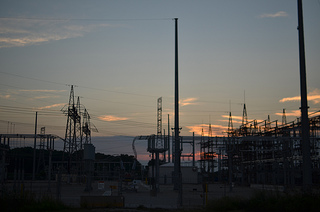Former FERC chairman Jon Wellinghoff recently made news by declaring that the April 16, 2013 vandalism of the PG&E Metcalf, California substation was “the most significant incident of domestic terrorism involving the grid that has ever occurred” in the U.S.
The electrical grid is vulnerable to outages in localized areas and to outages that can cascade through larger areas due to its many vulnerabilities and instabilities. The electrical grid is subject to complex sources of instability which include:
- indirect global disruptions (i.e., commodity flows, war),
- intentional disruptions (i.e., cyberattack, crime, terrorism),
- natural acts (i.e., lightning, earthquakes, storms),
- errors or omissions (i.e., accidents, design errors), and
- forms of instability inherent in electricity (i.e., rotor angle stability, voltage, frequency)
These sources are subject to variable redundancies and mitigation via security measures, synchrophasors, and other N – x criteria. Since most of the grid is built to at least N – 1 criterion (i.e., if one asset fails, there’s a redundant asset), the idea of the PG&E substation event as being a “dress rehearsal” or a “terrorist attack” seems like hyperbole to me.
Occam’s Razor (as well as Mr. Wellinghoff’s recent association with the Advanced Energy Management Alliance (AEMA), the first 501(c)(6) national advocacy organization for the demand response industry*) says crime is a more likely explanation (at least, from what I’ve read; of course, there could be unreleased, classified information to the contrary).
* “The only thing worse than being talked about is not being talked about.” – Oscar Wilde

 Sniper attack on power grid spurs anti-terror crusade
Sniper attack on power grid spurs anti-terror crusade

 Sniper attack on CA power grid spurs crusade
Sniper attack on CA power grid spurs crusade Attack on electric grid raises fresh concerns
Attack on electric grid raises fresh concerns